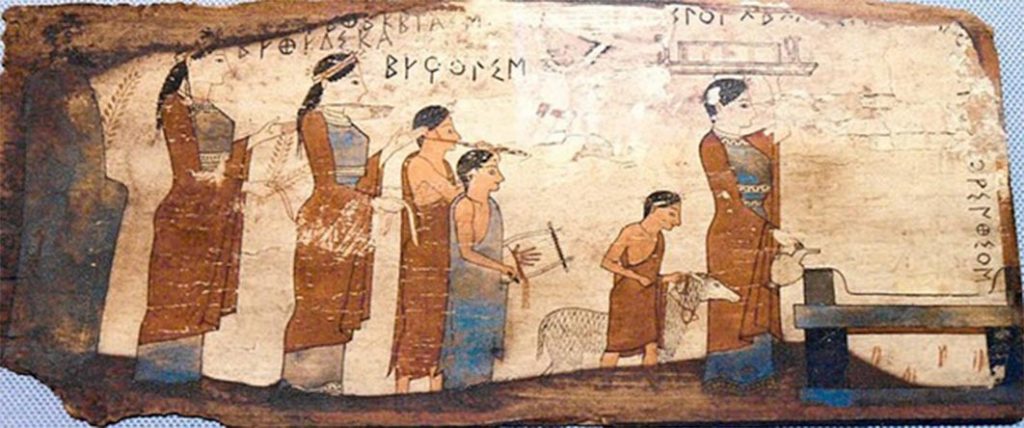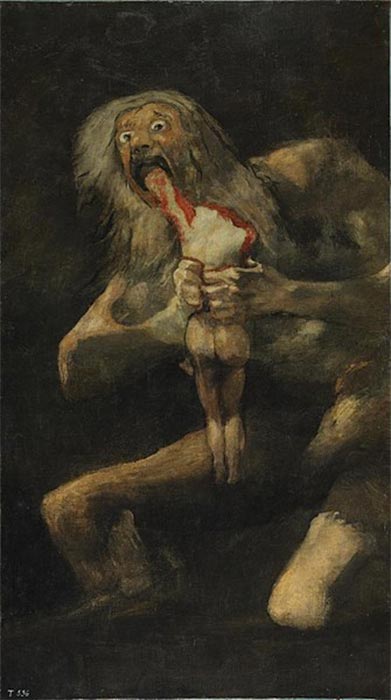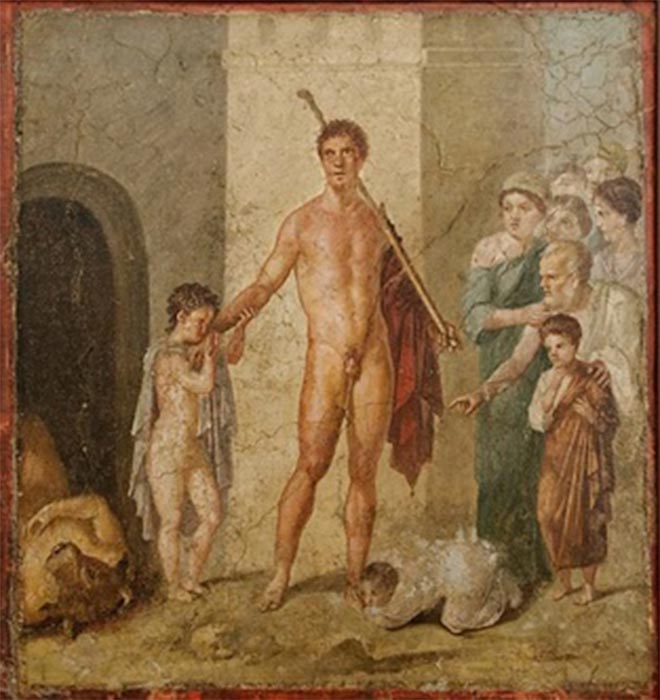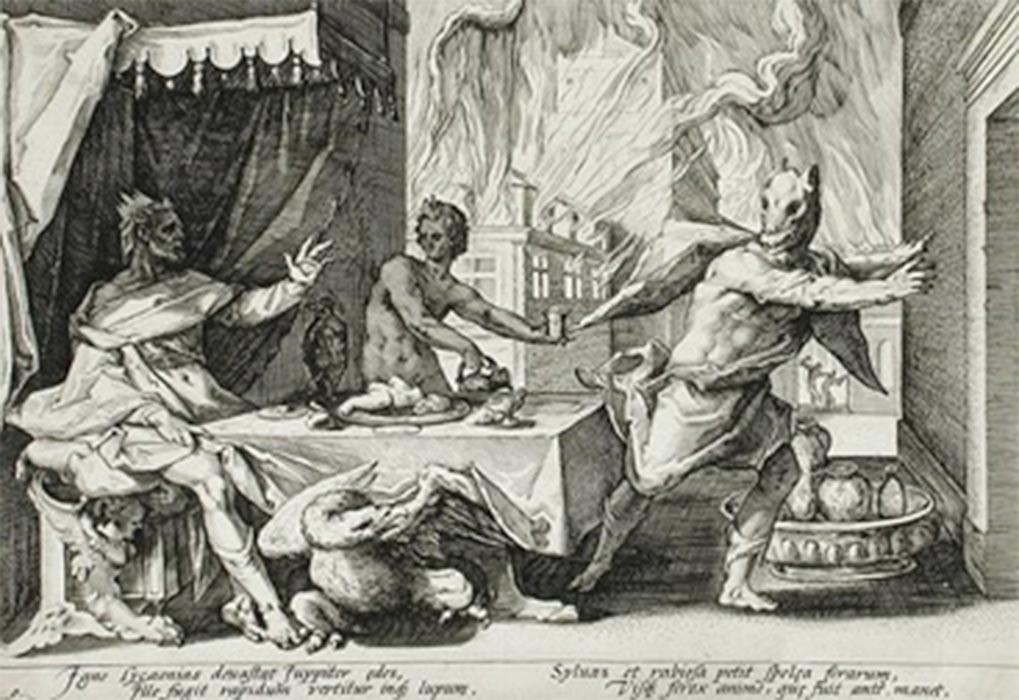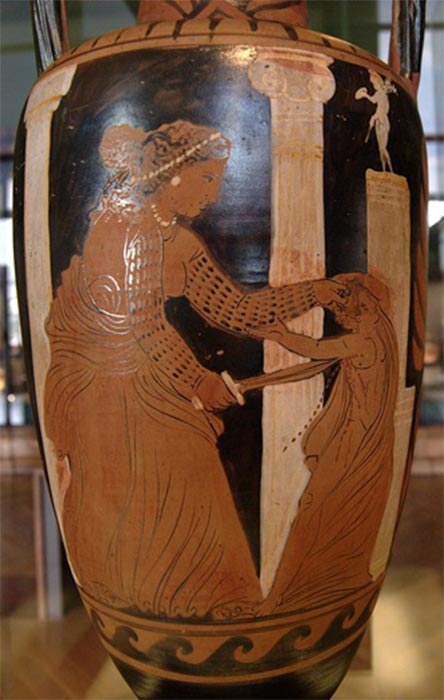In the Greek Peloponnese, high atop the summit on Arcadia’s Mount Lykaion (Wolf Mountain) lies an altar at one of the oldest and most revered of all primordial sanctuaries. Standing at nearly five thousand feet, with vistas of the entire Peloponnese peninsula beneath their feet, it is easy to understand the intimacy the ancients must have felt for the god of sky and thunder. Purportedly Zeus’s birthplace, experts now believe that the altar may predate Zeus by over a thousand years originally paying homage to a chthonic, more primal god. Indeed, Zeus’s birth atop Mount Lykaion may signify the very inception of Greek religion itself. A weather-god, Zeus was entreated during times of scarcity, not infrequent high above the clouds on Mount Lykaion. In a land prone to drought, famine and a thousand injustices, carnivorous gods loomed large ravenously roaming the earth in search of sacrificial victims. Zeus, one of the earliest gods of the Greek pantheon, was the most brutal and blood-thirsty amongst them.
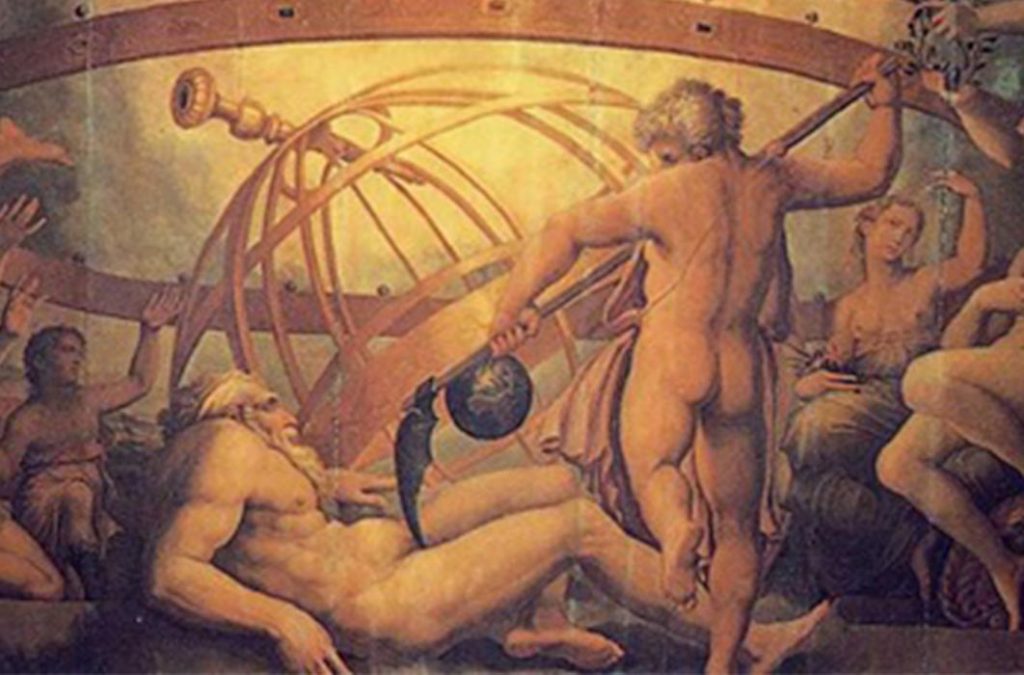
Son of Kronos—infant-eating chief of the primordial Titans—Zeus was king of the Olympian pantheon, dictatorial god of sky and thunder and sanctioned serial rapist whose fierce role in Greek mythology is cardinal. In order to appease his ever-capricious appetite, blood lust was the order of the day and sacrifice, his exacting requirement. At the hallowed ground of his circular ash altar possibly tens of thousands of creatures were sacrificed in his honor. The animals—typically sheep and goat and to a lesser extent pigs and cattle—were lined up to offer their lives to the sky god. But were there more than animals queued up on Zeus’s altar? If the ancients are to be believed, Arcadians were known to gift human boys to the sky god as well. Dismissing such reports as ancient hyperbole, human sacrifice in ancient Greece has been mostly disregarded by academia. But that may be changing. Much to the astonishment of archaeologists recently excavating the area, hidden amongst the thousands of animal remains on Zeus’s altar was the three-thousand-year-old skeleton of an adolescent boy believed to have been sacrificed in much the same way as his bestial counterparts.

While excavating Mount Lykaion in 2016, University of Arizona archaeologist David Gilman Romano and his team discovered the young boy’s remains. Gilman Romano asserts: “The one thing that is clearest is that we are not digging a cemetery. This is a sacrificial altar to Zeus, where thousands of sacrifices were made in antiquity. And in the middle of it, right in the middle, we found a human skeleton.” Because the resting place of the boy was an altar where sacrifices were made, his remains beg the question, did ancient Greeks practice human sacrifice? Certainly, the notion of human sacrifice was rife throughout ancient Greece indicated by the myriad myths associated with it. From the noteworthy sacrifices of Iphigenia and Polyxena along with others in the epic tradition to the fourteen Athenian boys and girls sacrificed to Minos each year to the countless classical plays of Aeschylus, Sophocles, and Euripides who frequently deal with the topic. Time and time again, human sacrifice is a common dramatic theme in ancient Greece. But aside from legend, even amongst ancient chroniclers—from Plato to Pliny the Elder to Pausanias—reports abound that the rural enclave of Arcadia was notable in its penchant for human sacrifice. Could these remains be evidence that the Arcadians practiced human sacrifice much as the ancient chroniclers had long reported? Further, the young boy’s body was found without a head leading some to surmise that he may have been at least partially cannibalized. If so, were the Arcadians cannibals, as their folklore suggests?

Before these questions are answered, some background on the area is useful. Arcadia is at the heart of the Peloponnesian peninsula which was dominated by the Mycenaean civilization during the Bronze age (3000-1100 BCE) with its culture especially flourishing from the fifteenth-thirteenth century BCE. Carbon dating from the recent excavation on Mount Lykaion dates the sanctuary of Zeus to the sixteenth century BCE, surprising some that the cult of Zeus may have its roots in the Bronze age. The collapse of the Mycenean period at the end of the second millennium BCE ushered in the era known as the Greek Dark Ages from twelve hundred to eight-hundred BCE. Because written artifacts do not appear in ancient Greece until the eighth-seventh century BCE, the Greek Dark Ages was striking for its absence of written records. Dated to around one thousand BCE, the boy’s remains place him squarely into the Dark Age void. Yet as a group, the Arcadians are believed to go much further back than this, tracing their ancestry to the prehistory of the indigenous proto-Greek “Pelasgians.” As such they were considered the oldest of all Greek tribes. In Greek folklore, they preceded even the moon itself. In fact, Arcadians had a reputation for being wild and were considered primitive by their neighbors. Spatially distant from urban centers, Arcadia was rustic, mountainous but most of all remote. As a result, influences from the outside were at a minimum leading the Arcadians to hold fast to their primordial traditions. Thus, bringing their rites into sharper focus could give us a glimpse into the religious practice of prehistoric Greeks.
The most important of these rites was the primeval festival of Zeus Lykaios (Wolf Zeus) which was likely held every four years. Some speculate that the festival may have preceded
even Zeus himself originally paying tribute to a more primal god. The festival—known to be rapturous—commemorated rites of initiation for young males on the cusp of adulthood. These initiation rites were accompanied by athletic contests which were called the Lycaon Games, believed to be a precursor to the Olympic games begun in 776 BCE on Mount Olympus a mere twenty-two miles away. While Greek worship involved pageantry: processions, absolutions, dancing and imbibing in every way, the main event consisted of making offerings to the gods or goddesses at whose altar they were honoring. In particular, the altar of Zeus was a forbidden precinct with only the purified allowed entrance. Amongst other things, purification rites involved bathing in the spring waters below the peak at the summit of the mountain. Especially because initiation rites or rites of passage compelled the god to influence a human in some way the rites were made sacred by the gift of animal sacrifice.
The offering wherein an animal was sacrificed was called thysia. At the Sanctuary of Zeus on Mount Lykaion, thysia was a major element of the festival. There was a solemn procession where the animals would be paraded to the altar. Always the young, the healthy and the most beautiful—insulting a god with an old, infirm or flawed creature could spur his wrath. Further, the gender of the sacrificed animals was dependent on the deity being honored. In general, goddesses preferred female animals, while the male gods preferred male animals. For Zeus, only uncastrated young males would do. Before being paraded, the animals were bathed then outfitted in ribbons, flowers and ornate garlands. It was an honor for the animal to be selected for sacrifice; in some ways the ancients considered sacrifice an act of love. Although festivals were celebratory, sacrifices were solemn and grave affairs. A sacrosanct act, sacrifice was considered a marriage between the sacred and the profane. Once the animal reached the altar, he would be slaughtered by an axe with a single blow. His spilled blood collected on the holy altar. While some portions of the animal were set aside for human consumption, the hallowed portion for the gods were bones wrapped in fat then burned. The belief was that the considerable smoke that resulted from the burned fat high atop the peak of Mount Lykaion was aromatic enough to reach the god of sky and thunder. Over the millennia, perhaps tens thousands of animals were sacrificed on Zeus’s altar in this way.
But animals were not the only ones sacrificed on Zeus’s altar. The discovery of the Lykaion boy’s remains is compelling precisely because the Zeus Lykaios festival was notorious for its sacrifice of young boys. For that matter—in the greater Greek cult—some believe that long before animals supplanted them, humans were routinely laid out on the sacred altar. Although more a phenomenon of rural communities than of urban centers, human sacrifice and its sometimes companion cannibalism have been around since time immemorial. During times of crisis, whether on account of famine, drought or natural disasters, pleas were made to placate the enraged and carnivorous gods. Experts speculate that human sacrifice represents a breakdown in an economic system; a collapse in community with its observance functioning as a means of stitching together a sense of social cohesion. In a form of self-abnegation, the ancients offered their gods the ultimate gift—a human life. The belief was that at the expense of a human life, they were preserving the lives of many. The word sacrifice itself denotes making something sacred; handing over from the human to the divine. While animal sacrifice was known to be a solemn affair in the ancient Greek ritual, human sacrifice must have been even more so. In particular, to put the sacrificial practices of ancient Arcadians into proper perspective, it is important to know what was occurring in the region during the Bronze Age. Less than three-hundred-fifty miles across the Aegean stood Minoan Crete (3000-1450 BCE).
The darling of the Bronze Age—long considered a prototype for the seat of Western civilization—even the Minoan civilization is known to have practiced not only human sacrifice, but cannibalism as well. To date, three separate excavations have reported both human sacrifice and cannibalism there during the twilight of the Bronze Age. But the excavation causing the most stir comes from a house in Knossos believed to have been a temple dated to Late Minoan 1B (ca 1450 BCE). Found there were the remains of at least four children thought to have been sacrificed. In charge of the dig, Professor Peter Warren of Bristol University asserts: “We uncovered 203 bones in a heap. They all belonged to children, probably less than 10 and certainly under 15 years old.” Their skeletal remains bear no evidence of disorder or disease. For all intents and purposes, the children appear to have been healthy upon their death. Warren goes on to add: “About 20 bones showed fine knife marks, like butcher’s cuts,” claiming that cannibalism likely occurred there. Most experts now agree with Warren’s assessment about the sacrifice and subsequent cannibalism of the children. One possible explanation for these dire actions is that a destructive earthquake may have compelled residents into taking drastic measures. In fact, many now believe that a string of violent earthquakes brought the Minoan civilization to its knees ultimately ushering in the Myceneans.
Forasmuch as the Minoans consumed their human sacrifices, is it possible that the Arcadians consumed their human sacrifices as well? Indubitably, cannibalism is at the very heart of the myth of King Lycaon of Arcadia for whom the mountain was named. Lycaon’s legend was considered one of the earliest foundational stories in Greek mythology. Thus even in antiquity it was considered ancient. He was the son of Pelasgus—one of the first mortals to walk the earth—and the founder of the cult of Zeus Lykaios and of the Lykaion games. Make no mistake, Lycaon was no paragon of virtue. Impudently, he tried playing a trick on the almighty Zeus. Setting out to test Zeus’s omniscience Lycaon offered the formidable god the roasted flesh of his own son—Nyctimus—in place of that of an animal. In virtue of being truly all-knowing, Zeus was having none of it. Enraged, the storm god struck Lycaon with a lightning bolt transforming him from a human into a werewolf. Thus, began a long tradition of cannibals becoming werewolves. The belief was that if a person acted like a beast, he would turn into one in a process known as lycanthropy. In antiquity when humans had a closer connection to animals, lycanthropy was not the fantastic notion it is today. After all, not only were wolves and humans about the same size and weight but wolves were abundant on Wolf Mountain hence had a role in the lives of most Arcadians. Part of the Lykaion initiation ritual involved mixing the flesh of humans with that of animals. In a game of chance, young males drew lots to determine who would eat the portion mixed with human entrails. According to the legend, once a person ate the flesh of a human, he would become a werewolf for a period of nine years after which time—if he abstained from eating human flesh—he would become human again. Alas, the initiate eating from the portion containing human flesh would be transformed into werewolf—posthaste.
In the earliest and only account of the myth written by a Greek, Plato discusses the process of lycanthropy. In Republic (388 BCE), Socrates is in dialogue with one of his pupils about the evolution of a ruler from protector to tyrant. Socrates asks:
“’What then is the beginning of the transformation from protector to tyrant? Is it not clearly when the protector begins to do the same as the man in the story which is told concerning the sanctuary of Zeus Lykaios in Arcadia?’ What story? he said. ‘How the man who has tasted the piece of human entrails is inevitably transformed into a wolf.”
The sage and circumspect Plato may have doubted the process of lycanthropy, but many believe that he did not doubt that cannibals lived amongst the Arcadian Greeks.
In another first, Plato was the earliest to write about the practice of human sacrifice on Mount Lykaion. In Minos (ca 350 BCE), Plato discusses how the Carthaginians practiced human sacrifice then relates that even in Greece, some areas were known to do the same:
“Whereas the Carthaginians perform it as a thing they account holy and legal…and not merely is it foreign peoples who use different laws from ours, but our neighbors in Lycaea (Lykaion)…offer such sacrifices even though they are Greeks.”
Although comprised of a band of city-states, by Plato’s time, Greeks had proudly defined themselves as one ethnicity who disdainfully viewed their “barbarian” neighbors as “other” where customs –such as human sacrifice—were supposedly routine. Of particular interest here, by the middle of the fourth century BCE, not only were most Greeks contemptuous toward those who engaged in human sacrifice, but they were warily suspicious that its practice was occurring amongst them.
Although human sacrifice in Arcadia was written about by several ancient historians, the following are reports from two of the more notable sources. Pliny the Elder (23-79 CE) in his Natural History recounts a previous author’s testimony of a sacrifice which occurred during Plato’s lifetime. But the item of interest is that not only was human sacrifice still practiced into the fourth century BCE (as Plato had reported), but evidently cannibalism was as well. Like a hand in glove, time and again ancient historians write about the practice of both human sacrifice and cannibalization in rustic Arcadia. Salient to this discussion, because his remains were without its head some scholars contend that the Lykaion boy was at least partially cannibalized. As with animals, heads were often removed from human sacrificial victims, cut up and possibly consumed. While most believe that the Lykaion boy was sacrificed, whether or not he was cannibalized is still up for debate.
Strikingly, fully twelve-hundred years after the Lykaion boy’s tragic demise human sacrifice in Arcadia was still a topic which was not only fascinating for the ancients but may still have been in practice in the second century CE. Written a five centuries after Plato is a passage by Pausanias (110-180 CE) which recounts how the Arcadians practiced human sacrifice during his visit there:
“Upon the altar they sacrifice to Zeus Lykaios (Wolf Zeus) in secret; and I was glad to not inquire too closely into those things for the sacrifice, but let it be as it is and as it was from the beginning.”
Because they sacrificed a human in secret, Pausanias would have had no direct-hand knowledge of the event, yet he was cautious about making too many inquiries about it lest he end up on the hallowed altar himself. At this point it should be noted that in 371 BCE, the city of Megalopolis was founded—the first urban development in rural Arcadia. Henceforth, it has been presumed that from that time forward the cult was celebrated in Megalopolis instead of on Mount Lykaion. However, Pausanias’s account of the rites in 180 CE on Mount Lykaion challenges this notion. A historian of some renown, Pausanias is resolute that the practice of human sacrifice was on-going on Mount Lykaion: “as it was from the beginning.”
But when did human sacrifice actually begin in Arcadia? Although Gilman Romano’s team dates the sanctuary of Zeus to the sixteenth century BCE, in unearthing its ash altar they were astounded to discover pottery dating back to the three-thousand to twenty-one-hundred BCE timeframe, suggesting that the altar may have been used as a place of worship by proto-Greeks during the dawn of the Bronze Age. Much as their successors would one day pray to Zeus, these indigenous people paid their respects to Zeus’s predecessor—a chthonic god of sky and thunder. Most importantly, likely they made human sacrifices to him and—if mythology is any indication—engaged in cannibalism as well. Experts now believe that human sacrifice was practiced throughout the region during the Bronze Age into the Greek Dark Ages and possibly well beyond that. In his seminal book Human Sacrifice in Ancient Greece, Dennis Hughes ponders:
“But was there not fire where there is so much smoke? How is it possible that so many of the Greeks believed that their own ancestors (or in some cases contemporaries) practiced human sacrifice, if they did not? And how could the very idea of human sacrifice have arisen, without any basis in actual practice? Is it credible that human sacrifice was a purely imaginative creation, existing from the beginning solely on the level of myth?”
Since the beginning of time, storytelling has been what separates us from our simian forebears. Part and parcel of who we are, stories or myths have been interwoven into our history making it increasingly difficult to tell one apart from the other. Mythology informed lives saliently in ancient Greece, thus the parallels between mythology and history are often striking there. As a consequence, myths are an expression of cultural memory with a basis in reality. But the cultural memory of human sacrifice in ancient Greece is one that most modern classical Greek historians would just as soon see buried. Since up until now the definition of an advanced civilization is one which forbids the practice of human sacrifice, many academics have been uncomfortable that ancient Greece—the seat of Western civilization—engaged in its horrific practice. But the fact is that all ancient civilizations—both great and small—practiced human sacrifice to one degree or another. Previously a taboo subject, human sacrifice in ancient Greece is increasingly coming under scrutiny in academia. This renewed interest is due in part to the discovery of the Lykaion boy’s remains on Zeus’s sacrificial altar in Arcadia—at long last validating the stories told by the ancients for hundreds of years.
On that fateful morning, the amber sun cast its golden glow over Wolf Mountain—a favorable portent from the sky god. But petulant Zeus was hungering—as were his disciples. So the ritual began. Was the boy decked out in garlands or wrapped in a tunic? Was he blindfolded or allowed to see? Were his locks freshly washed or roughly sheared? We can only guess. The absence of written records makes speculators of us all. But some things are certain. Fine in form, the boy was healthy, vital and handsome. Zeus could do with no less. Like his bestial counterparts, he was bathed before his sacrifice. Likely, he was placed on a litter and paraded through the sanctuary. After all, he was the main event. It was a slow march to the circular altar—the boy’s final resting place. The cacophony of the chanting in unison with the wailing was deafening as his litter finally reached the altar. Suspended somewhere between life and death—between the here and the hereafter, his young body fervently clinging to the last vestiges of the only life he would ever know. The roar, the thunder, the awful howl—until the ax came down.
This article was published by Ancient Origins in March of 2020




